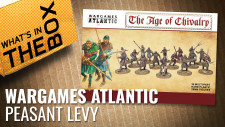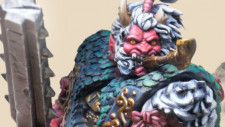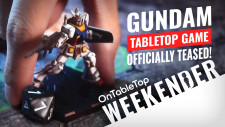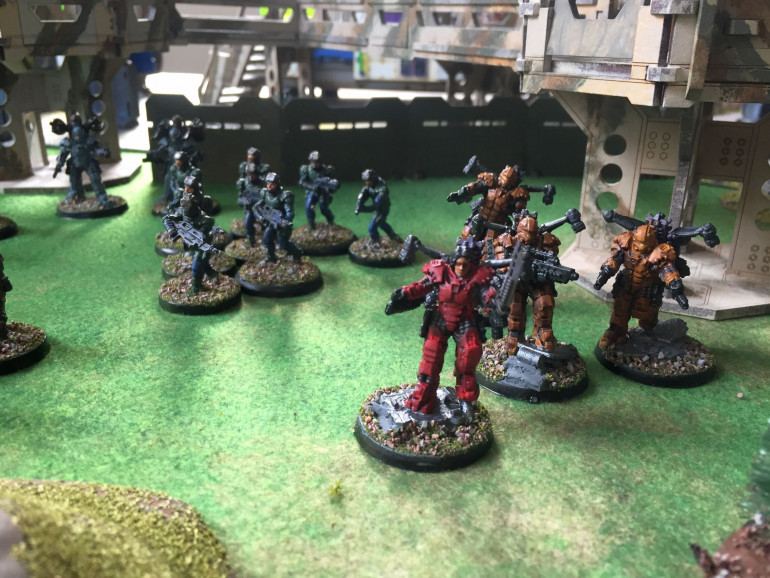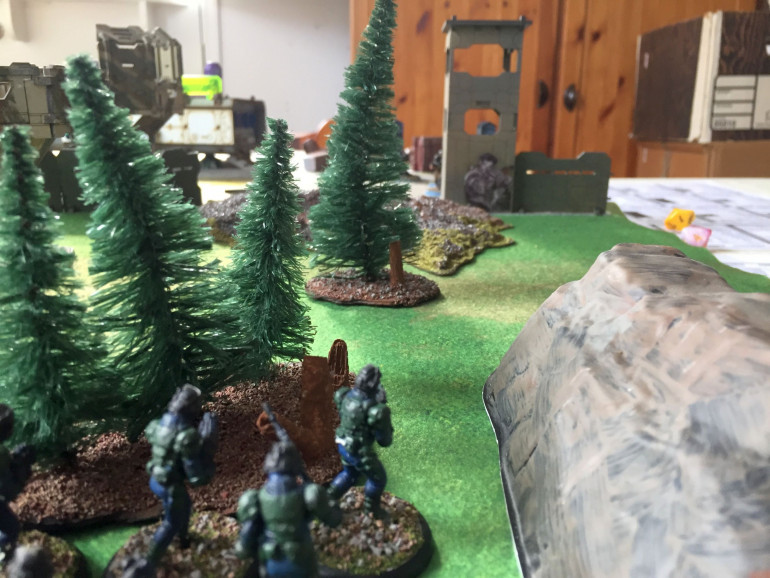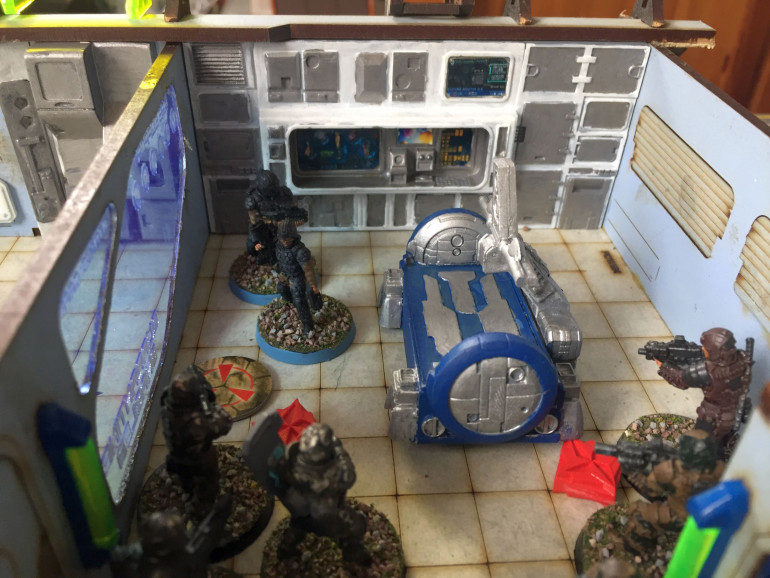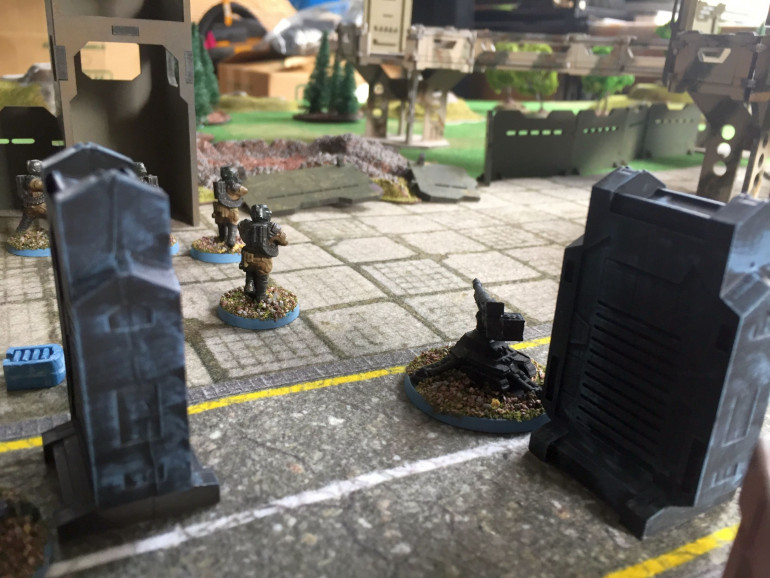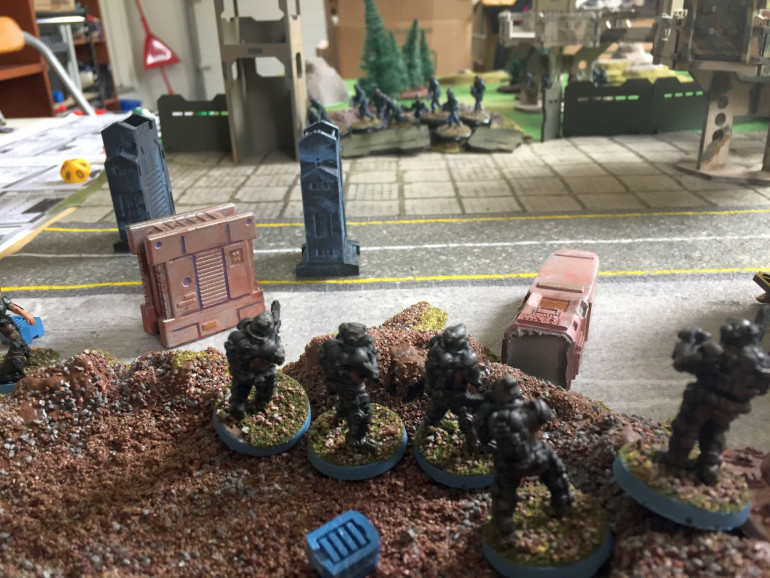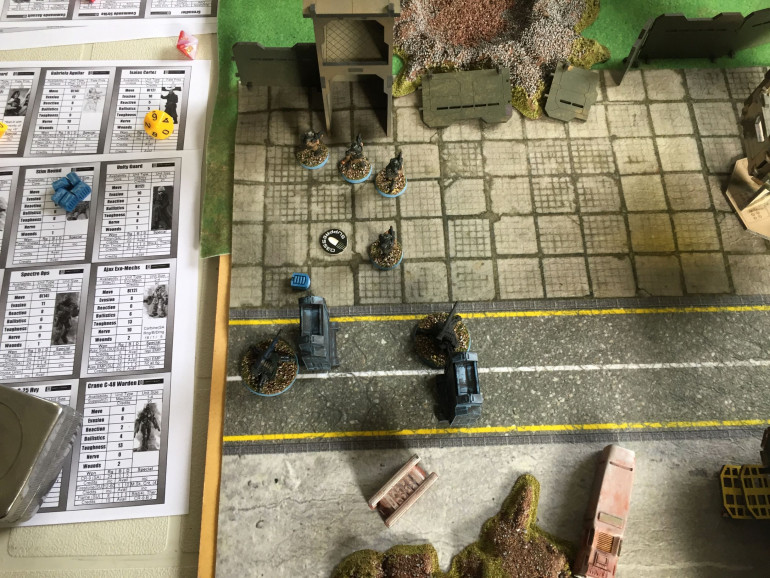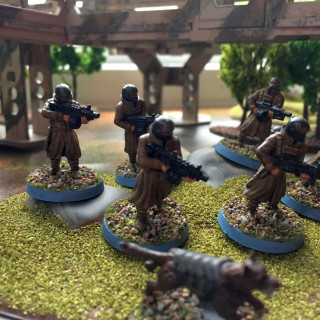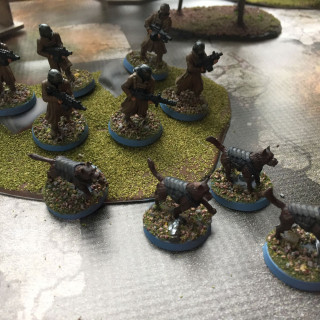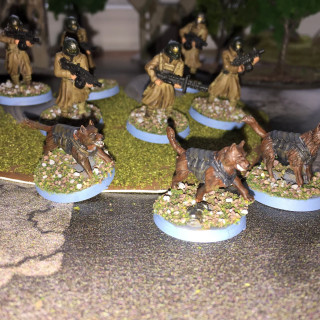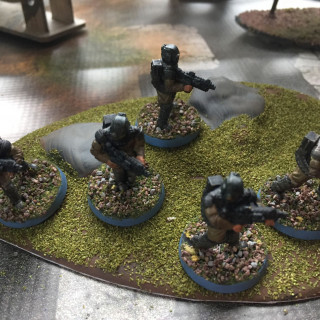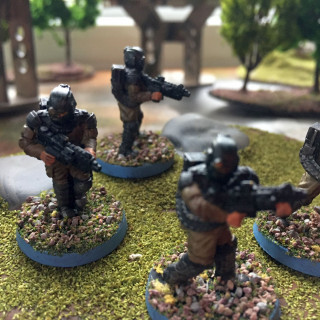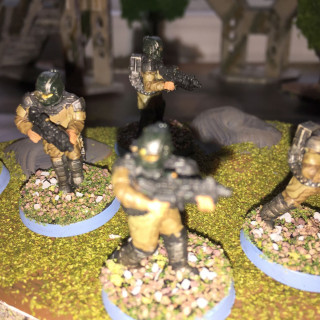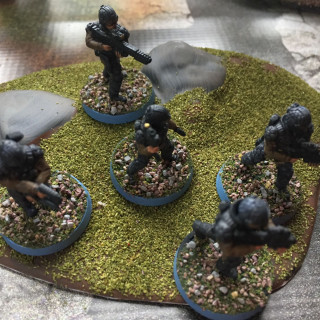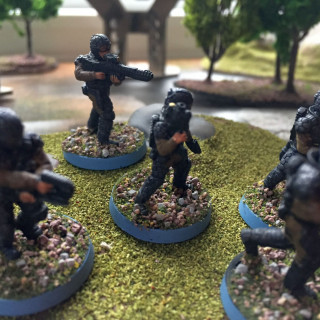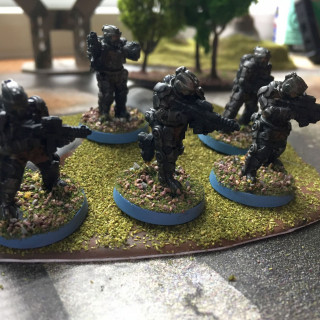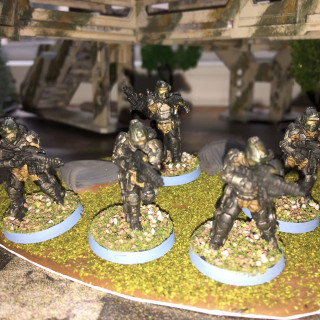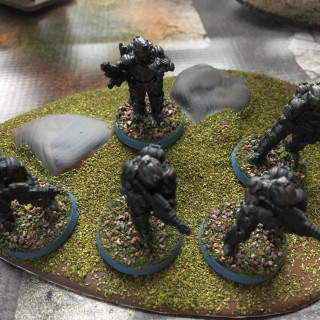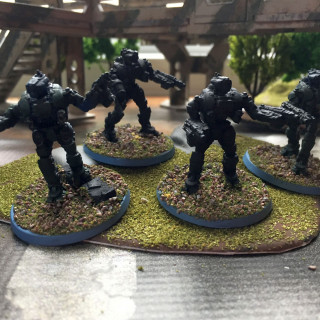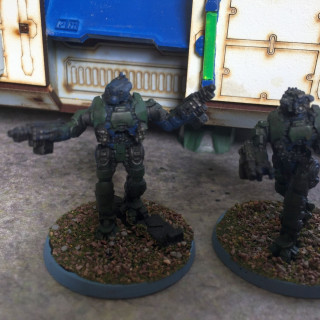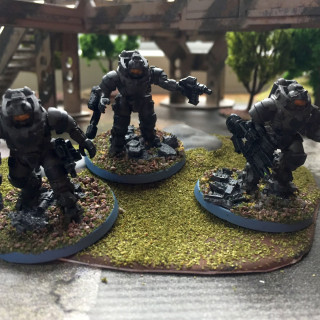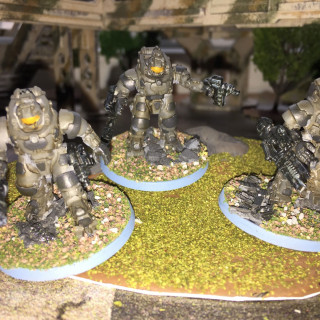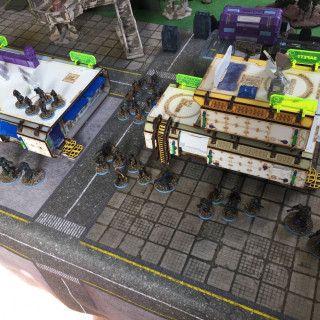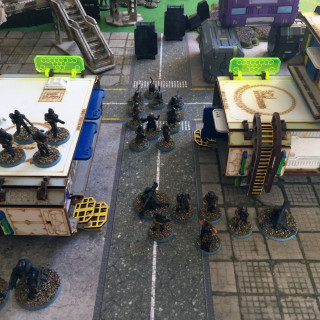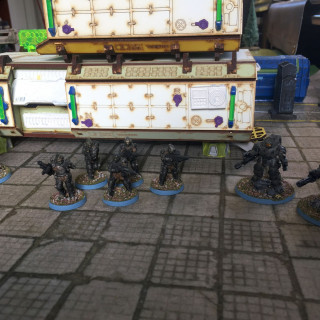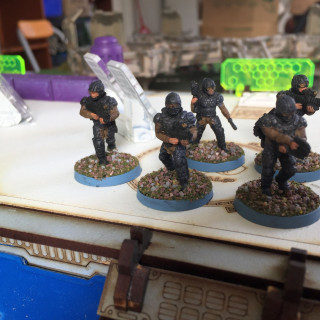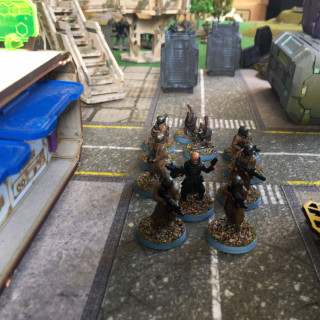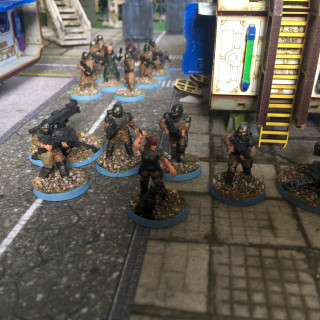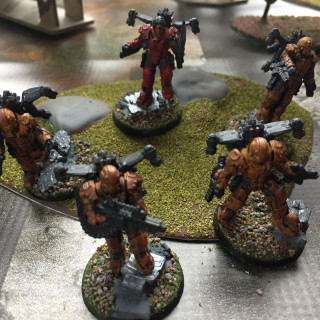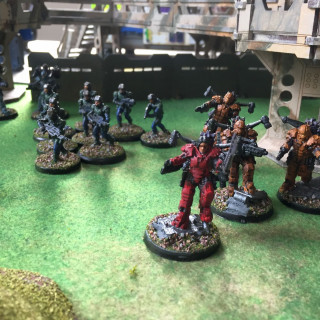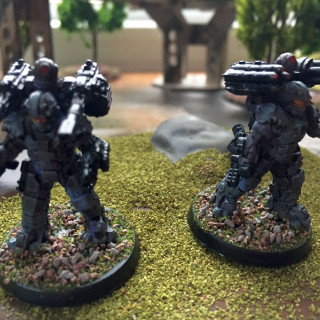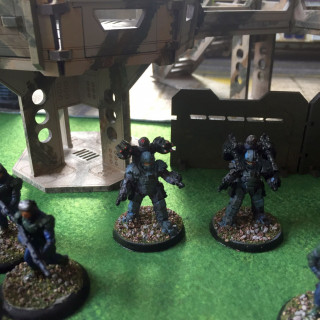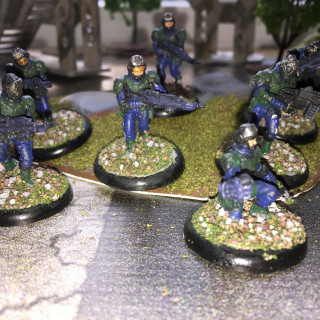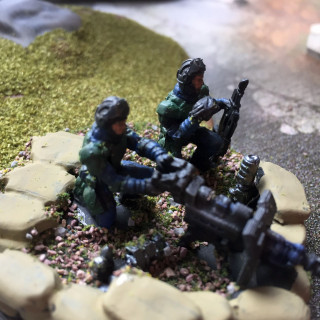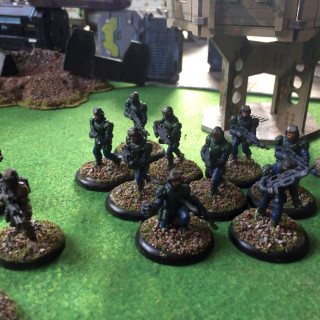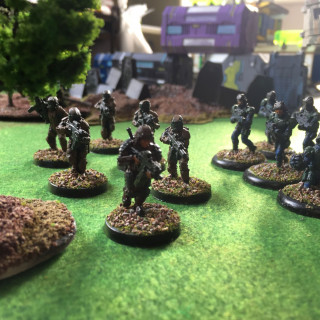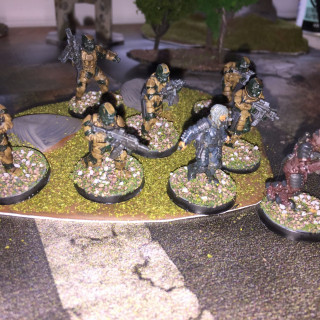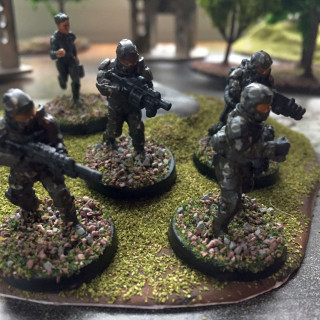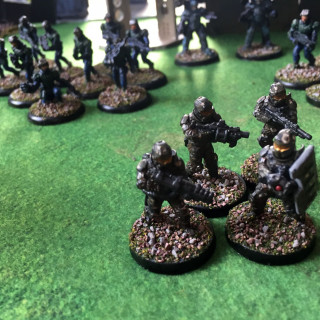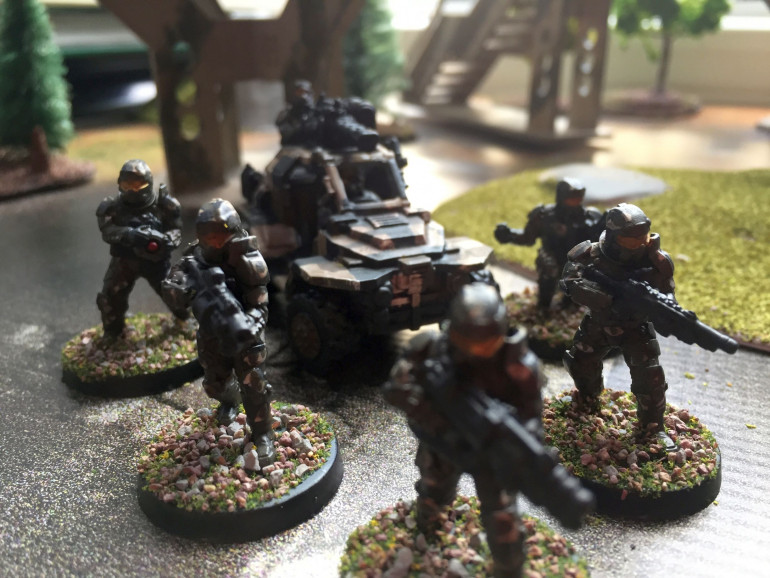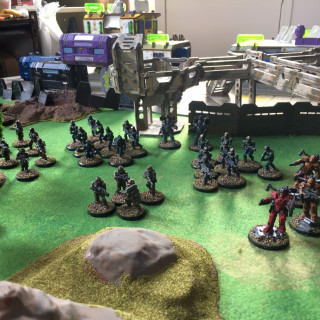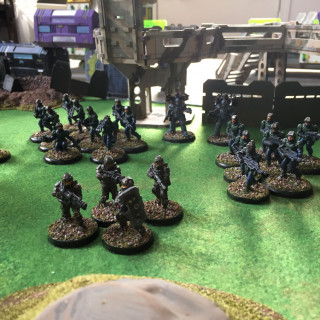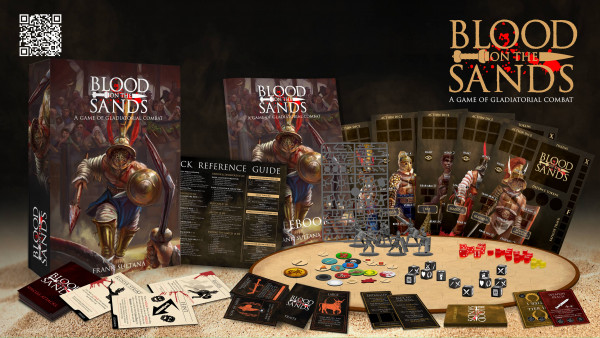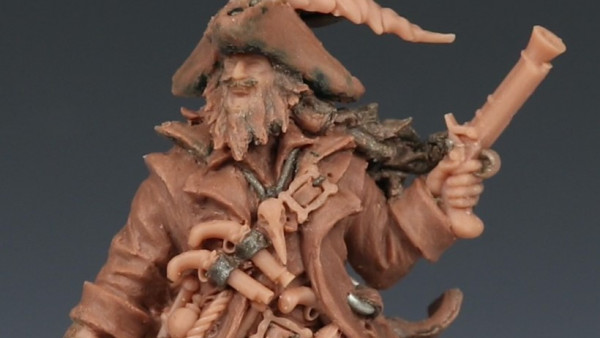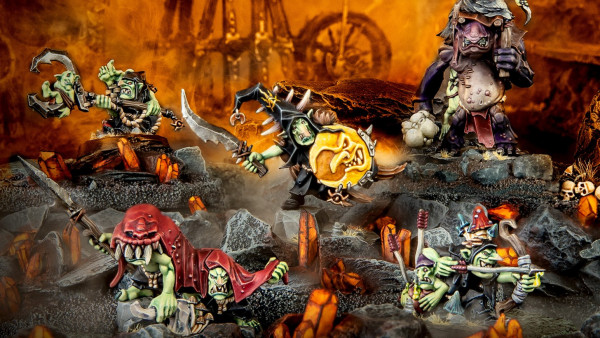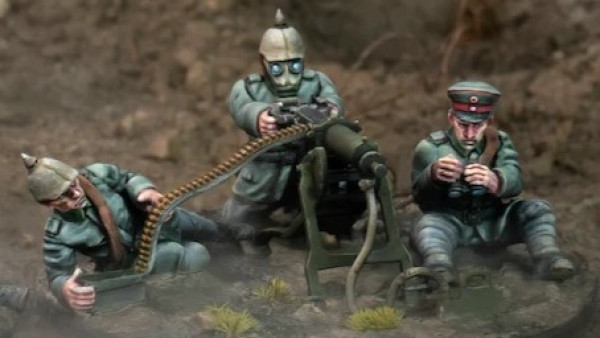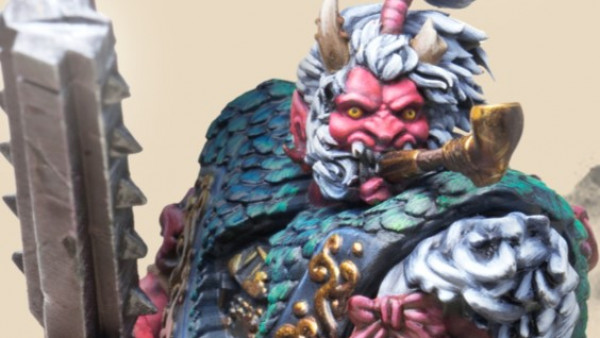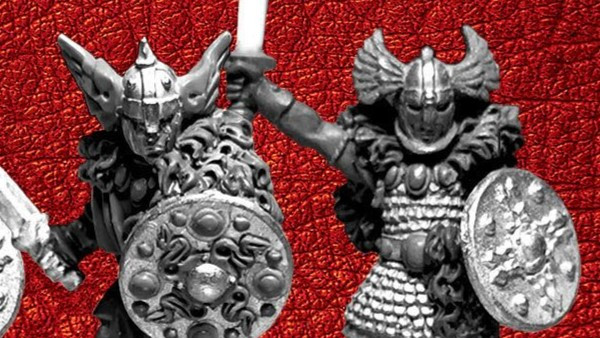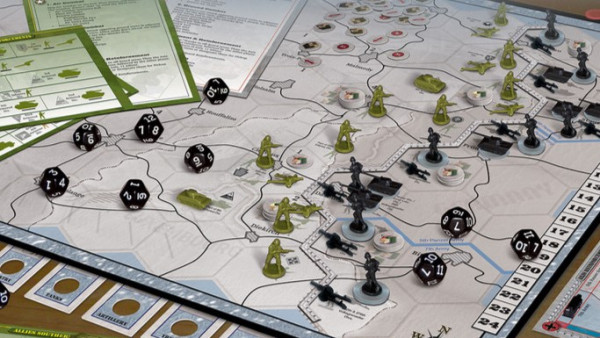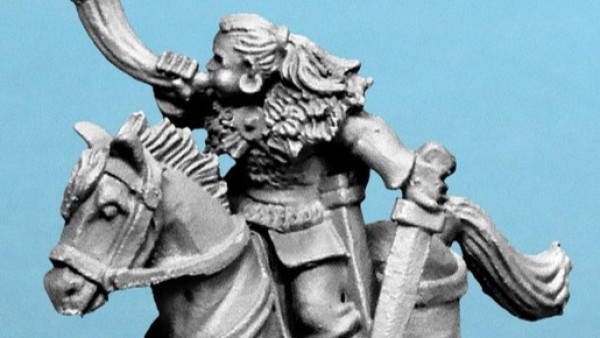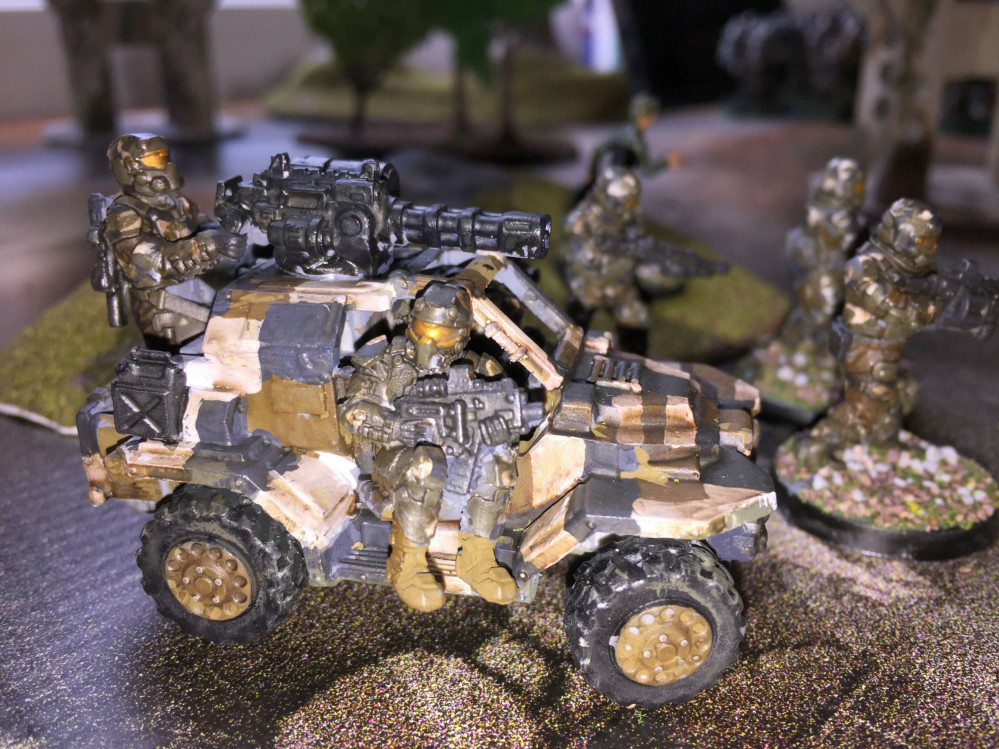
Afterlife – Models and Gameplay
Recommendations: 2
About the Project
Afterlife is a unit-based large skirmish game, with a strong narrative component. Future-based warfare between factions in a crumbling society form the heart of the action. The Unity Council are the planetary government and field strong flesh and AI forces to maintain their power. The Pan Continental Republic is a conglomerate of corporate interests and nobility who aim to release the population from the government's yoke. Combining cutting edge technology and lightning strikes, they can prove a match to the Unity Council. This project will show my models and battle reports to introduce this system created by Anvil Industries. I've also homebrewed a third force from one of Anvil's other ranges, that may make an appearance. The game itself is d10 based and has some unique features including fog of war, I Go You Go with reactions, and advanced urban combat with a breach and clear mechanic for storming enclosed areas. A can of fun!
Related Game: AFTERLIFE: The Shards of Liberty
Related Company: Anvil Industry
Related Genre: Science Fiction
This Project is Completed
Afterlife - Introduction
Afterlife: The Shards of Liberty was the second Kickstarter by Anvil Industries. It was completed in 2014 and delivered in 2015 with the aim on building on their previous Kickstarter to flesh out a full game with two factions and narrative backstory. The models created are well-sculpted resin figures loaded with detail and variety. They are truer to 28mm scale and do not have the heroic proportions seen in other ranges. Some care may be needed if combining with models from out of the range.
The game plays as a unt-based large skirmish. A 4’x4′, terrain dense play area is suggested and under the typical scenarios all units start off board. Rounds are played as I Go You Go, with units initally entering the board in the hidden state. This affects how they can be targeted and allows some units extra movement until they break the status or are discovered. Units may react to attacks against them, with a roll-off potentially allowing one side to resolve first. Subsequent attacks on a unit lessen their ability to react and may even give them a suppressed condition. Coordination between your own units is key to lock down the enemy or parts of the board to achieve objectives.
A model or unit’s stats include Move, Evasion, Reaction, Ballistics, Toughness, Nerve and Wounds. From a simple ranged combat example, an attacker rolls a d10 for each shot fired (game is d10-based) and adds the roll to the unit’s Ballistics value. These totals are then compared to the target’s Evasion, a static value. Typical troops have a Ballistics value of 4, and an Evasion of 10. On average, in this example, 50% of shots will hit. Weapons have a max range (some larger weapons a minimum range), but there are no modifiers to the Ballistics roll. Of the shots that hit, a d10 is rolled and added to the weapon’s Damage value. This is compared to the target’s Toughness to determine the number of wounds. Through various combinations of Evasion and Toughness a target’s skill at avoiding damage or variances in equipment allow a lot of diversity in creating unique units.
Wounds are allocated by the target’s owner with some set rules. The figure must be in line of sight. Multi-wound models with at least one wound already allocated must receive a wound. Models not in cover must receive a wound before those in cover. Finally those models in cover that received a wound will get a cover save based on the type of cover.
Another interesting feature is Reactions. As attacks are declared, the target unit can attempt a Reaction test. Both sides roll a d10 and add the unit’s Reactions value. If one side beats the other by 3 or more, they can act first and models are removed before they can fire back. Otherwise they are simultaneous. You can always fire back, so moving around units that have already activated does not ensure safety. A control on this is that if the same unit is subjected to consecutive attacks, their Reaction Test gets a worsening penalty. A unit under sustained fire will begin to lose models before reacting. The suppression rule may also limit a unit’s ability to react.
Units must maintain a cohesiveness of 3″, but not all models in a unit have to move. If a model moves 2″ or less (re-positioning), it is counted as stationary. This comes into play with some heavier weapon types that don’t allow a move and shoot or do so with a lower rate of fire. This allows some flexibility in moving a squad for better effect without compromising the combat effectiveness because all models were forced to do the same action. Movement rates are in the 8-10″ range and up to 16″ for a run. Despite starting offboard, unit’s can quickly close with the enemy or flank and redeploy.
Fog of War comes into play with the Hidden status. All units come into play Hidden until they are detected or the condition is lost by the unit’s actions. A Hidden unit can move further on its turn and is not affected by some area weapons. They cannot be attacked until revealed. A detection test pits a unit’s Reactions value + 1d10 against a target’s Evasion. This is another way a unit’s special equipment or concealment abilities can be factored into their stat line.
Suppression is a condition that is triggered by hits when attacked and is tested against a unit’s Nerve. A nerve test can be further modified if the unit received wounds or has been forced into consecutive suppression tests. Failing a test gives the unit a suppression marker and it is not allowed to take Reactions. If a unit receives a second suppression marker, it also gets marked as activated, if not already, and cannot take any actions or reactions the rest of the turn. All suppression markers are removed at the end of the turn. Doubly suppressed infantry units with less than half their starting strength are removed as routed or destroyed.
A final special rule interacts with dense urban terrain and resolves actions of storming a room or enclosed space. The Breach and Clear resolution provides a modified turn and reaction order that allows multiple units to interact to try and shift defenders from a location. Reaction order is determined for each unit and attacks resolved. If one side is not totally removed, remaining wounds are totaled with the defender getting a bonus. Highest modified total wins the action. If the defender loses, they must be able to retreat through an access or are destroyed. This process was shown on a Weekender a few years ago when the developer was on for an interview (using Antenociti’s Workshop pre-Kickstarter Habitat terrain samples).
The Factions - Unity Council
Unity has a nice ring to it, but for many the government’s hand is overbearing. Popular unrest has flared to outright war as centuries of sole rule have been challenged in the past decades. The Council was slow to react, at first, but have shown organizational agility in fielding new forces to counter the threat posed. Machine-based troops and support and battlefield coordination have levelled their initial gaps in the tech war. The emergence of strong and charismatic leaders have won victories in the field, but more importantly, have swayed large groups of the population to believe in their cause.
Unity Guard – A step above the general infantry, these troops are tasked with crushing dissent and protecting critial installations. Solid troops, built for close in fighting, they also benefit from an array of supporting units to give them extra punch. A core infantry unit with a higher than average Nerve value. Their Enforcer Shotgun is outranged by other weapons, but does respectable damage. A flame thrower upgrade can be added to the unit for added close in punch. Subordinate units can also be attached to them including weapons platforms and Stim Hound packs.
Crane C-25 Heavy Infantry – have an augmented heavy weapons harness that give them the ability to bring a heavier weight of fire to a standard infantry role. Better on defence than when forced to move, these troops excel at holding positions. They have a slower movement rate than typical but enhanced Toughness, fitting with their heavier gear. Their CR-6 LMG has a long range and enhanced rate of fire if stationary. As some members of a unit may only move 2″ and count as stationary while others move their full amount, this allows the Crane C-25’s to leapfrog and sustain heavier fire as long as they can stay in cohesion.
Spectre Operatives – using an advanced adaptive camouflage, these elite troops are experts at infiltration and maneuver. Their equipment (armour makes it harder for enemy to detect them when they are hidden) and weapon (dual profile with a silenced, sniper option) let them ambush their foes from afar. However, they are veteran fighters and are the equal of the opposition’s elite up close.
A truly elite light infantry (*) force, they have superior stats across the board. Coupled with their specialized weapon and equipment they are a very flexible unit.
* Light Infantry can run and still attack with small arms. They can also infiltrate closer while remaining hidden.
Recon Tracer Exo-Mechs – a light exo-suit provides durability and speed to these hybrid troops. They carry a standard small arm into battle, but can absorb punishment and quickly cover ground to lead an assualt. Their stat line makes them fast, tough and hard to hit while their Tracer Rifle has good range and respectable damage.
They are the only unit that counts as both Exo-Mech and Infantry types. The Mech abilities let them pass over terrain and obstacles more easily. The infantry class lets them benefit more from cover. A solid unit that is hard to pin down and tough to shift, but can quickly exploit a gap.
Crane C-48 Warden Mech – a large bipedal battle platform, these machines combine dual cannons and supporting limited-shot missiles into a package that strikes fear into Pan Con forces. The inherent slowness of the AI platform is their only weakness, but they are a target that needs to be quickly overwhelmed.
These 2-wound monsters have thick armour requiring some lucky hits or concentrated fire from heavier weapons. They can split the fire of their weapon systems, but have only average Ballistics skill and are slow to react.
Ajax Exo-Mech – this heavy piloted warsuit is the pinnacle of UC technology, though is still a rare sight on the battlefield. Custom configurations can alter its role to include smart grenade launchers, a minigun or an EMP launcher. Combining mobility and protection, this Exo-Mech cannot be ignored.
Unity Council 1500 Point Force
Unity Council special rules:
– Sphere uplink – Machine units gain bonus to Detection or Reaction roll-offs of +1 per other Machine or Exo-Mech unit that has LoS to target (max +3)
– Advanced Targeting – Exo-Mech unit gains +1 to Ballistics for every non-suppressed Exo-Mech unit with LoS to target (max +2)
6x Unity Guard (Core unit), + flamethrower upgrade
-4x Stim Hounds attached
-Isaias Cortez, Leader attached
4x Crane C-25 (Core unit)
-2x Bastion Platforms attached (2x grenade launcher)
-Ellenor Renard, Leader attached
5x Tracer Recon (Core unit)
2x Crane C-48 Warden (Support Unit)
2x Ajax Exo-Mech (Elite unit), Smart Grenade Laucnher + MiniGun
5x Spectre Ops (Elite unit)
The Factions - Pan Continental Republic
What began as hushed discussions and distress from the strain the Unity Council placed on those outside the inner circle, soon became full-fledged talk of rebellion. The Pan Continetal Republic grew from deep seated resentment at the hubris of the Unity Council. Corporations were approached by those who craved a more direct route to freedom and an organized resistance came together, drawing in many who would never share the riches of the Council and their ilk.
Pulse Mechs – not just an exo-suit, but an extension of the pilot itself, pulse mechs represent the cutting edge of technology. Armed with a pair of high damage mag carbines, the suit combines the protection of heavily armoured battle gear with great mobility.
The paired mag carbines have good range and enhanced RoF and damage, making them a viable threat to any unit. An upgrade option gives them a heavier frag rifle with extended range and RoF. Combined with optional flight packs and Pan Con’s special abilities, this unit is a hit and run master.
Pulse Mech support – Heavier cousins to the Pulse Mechs, the support variant forgoes some maneuverabilty to mount a heavy weapon system. Either the twin autocannons or missile systems would normally be vehicle mounted or in an emplacement. On the support mech, these systems can be brought up along with the attacking force to provide heavy fire.
Autocannons can range across the board and cause threat to any opposing unit. Missile units pack less of a direct punch, but can target lock for better chances to hit as well as handle clusters of troops.
Grenadier team – the standard infantry forces of the Republic are heavily armed, armoured and versatile. Grenadier teams are typcial of these well-drilled troops and can engage across a wide range band with their standard battle rifle or anti-armoured support.
Better protection is traded off for less mobility as compared to their Unity Council counterparts. Their weapon packs a bigger punch over a longer range.
(Some old Mantic Warpath Marines are standing in for my Grenadiers, as the models came from Anvil’s first Kickstarter)
Commando Strike Team – the elite forces that strike deep into the heart of the Unity Council form Commando Strike teams. Relying on speed and short range firepower, these units aim to get in quickly to complete their missions.
The Strike Team has a stat line that makes them fast, reactive and solid troops able to shrug off suppression. Their weapons are weaker with a shorter range, but put out a high volume of shots that get stronger in close quarters. They are light infantry which gives them even more flexibility.
Commando Assault Specialists – Assault specialists train under the same doctrines as the Strike Teams, but aim to pack a bigger punch upon arrival. The slums of the megacities are their homes and they are equipped to move swiftly through this urban jungle.
Better protected standard infantry, these specialists can be kitted out with an array of specialized equipment from shields to breaching charges to thermal lances, ensuring they won’t be held up by obstacles.
Pan Continental Republic 1500 Point Force
Pan Con special rules
-Feint – can always choose to take the first action of a turn, but may not attack with that unit
-Hit and Run – each turn, one unit may attack then move
8x Grenadier Team (Core Unit) with Smoke grenades
-1x Field Commander
8x Grenadier Team (Core Unit)
5x Commando Strike Team (Core unit)
-Idaho Yoshida, Leader Attached
4x Commando Assault Specialist (Elite unit)
-Smoke, Shield, Grenade Launcher
4x Pulse Mech (Elite unit), Flight Packs, 1x Frag Rifle
-Madison Yoshida, Leader Attached
2x Support Pulse Mech – Autocannons + Missile System





























![TerrainFest 2024 Begins! Build Terrain With OnTableTop & Win A £300 Prize! [Extended!]](https://images.beastsofwar.com/2024/10/TerrainFEST-2024-Social-Media-Post-Square-225-127.jpg)

